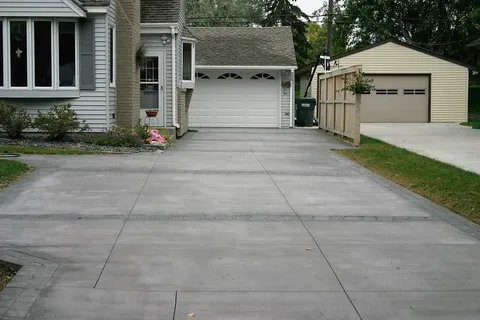Concrete driveways are durable, long-lasting, and a popular choice for homeowners. However, like any other surface, they require proper maintenance to retain their appearance and functionality. Regular care ensures your driveway remains in good condition for many years and helps prevent cracks, stains, or other forms of damage. This article explores the essential maintenance required for concrete driveways to keep them looking great and performing well.
Why Is Concrete Driveway Maintenance Important?
Maintaining your concrete driveway not only enhances its aesthetic appeal but also ensures its structural integrity. Without proper care, concrete driveways are susceptible to damage from weather, wear, and tear. Key benefits of maintenance include:
- Extended Lifespan: Regular maintenance can increase the lifespan of your driveway, helping you avoid costly replacements.
- Prevention of Cracks and Damage: Concrete driveways can develop cracks due to pressure, weather, or aging. Proper maintenance helps prevent these issues.
- Enhanced Curb Appeal: A well-maintained driveway adds to your home’s overall appearance, boosting curb appeal.
- Increased Property Value: A well-kept driveway contributes to the value of your property, which is important if you plan to sell your home.
Regular Cleaning of Concrete Driveways
One of the simplest yet most important maintenance tasks is regular cleaning. Over time, dirt, debris, oil stains, mold, and algae can accumulate on the surface of your concrete driveway, leading to discoloration and a dull appearance. Routine cleaning helps to prevent these issues.
Here’s how to clean your concrete driveway:
- Sweep the Surface: Begin by sweeping away dirt, leaves, and debris with a stiff-bristle broom.
- Pressure Wash: Use a pressure washer to remove stubborn dirt, grime, and stains. Be careful with the pressure settings to avoid damaging the concrete surface.
- Use Cleaning Solutions: For stains such as oil or grease, apply a suitable concrete cleaner. There are specialized cleaners available for tough stains.
- Rinse Thoroughly: After applying cleaner, rinse the driveway thoroughly to remove all soap residue.
Cleaning your driveway at least once a season helps maintain its appearance and prevents debris from damaging the surface.
Sealing Concrete Driveways
Sealing your concrete driveway is essential for protecting it from the elements. A concrete sealer creates a protective layer that guards against water penetration, stains, oil, and UV damage. This is especially important for concrete exposed to harsh weather conditions.
Benefits of sealing:
- Protection from Weather: Sealing helps protect your driveway from freeze-thaw cycles, preventing cracks and surface deterioration.
- Stain Resistance: It makes the surface resistant to stains from oil, chemicals, and other substances.
- Enhanced Durability: Sealing adds a layer of protection that can extend the lifespan of your driveway.
- Improved Aesthetics: Sealing restores the color of your concrete, giving it a fresh, clean look.
It’s recommended to seal your driveway every 2 to 3 years, depending on the level of exposure to elements and wear.
Repairing Cracks and Holes
Cracks are one of the most common issues with concrete driveways. These can be caused by the natural settling of the ground, freezing and thawing cycles, or heavy vehicle traffic. It’s crucial to address cracks and holes promptly to prevent them from worsening.
Steps for repairing cracks:
- Clean the Crack: Clear out any debris or dirt from the crack with a wire brush or air compressor.
- Fill the Crack: Use a concrete crack filler or sealant to fill the crack. For larger cracks, you may need to use a concrete patching compound.
- Smooth the Surface: After filling, smooth the surface using a putty knife or trowel to ensure it’s level with the surrounding driveway.
- Allow Time to Dry: Let the repair dry completely before using the driveway.
For holes or larger damage, you may need to apply a concrete resurfacer to restore the surface and ensure stability.
Protecting Concrete from Salt and De-icing Agents
In colder climates, salt and de-icing agents are commonly used to melt snow and ice, but these substances can cause long-term damage to concrete driveways. Salt can penetrate the surface of the concrete, leading to cracks, scaling, and surface deterioration.
To protect your driveway:
- Use a Concrete Sealant: Sealers can help prevent salt from penetrating the concrete surface.
- Clean After Winter: After winter, wash your driveway thoroughly to remove any remaining salt or chemicals.
- Use Alternative De-icers: Consider using non-corrosive de-icing products, such as sand or environmentally-friendly de-icers, to reduce damage.
By protecting your concrete driveway from salt, you’ll extend its lifespan and keep it looking good.
Preventing Stains on Concrete Driveways
Concrete driveways are prone to staining from oil, grease, gasoline, and other substances that come into contact with the surface. These stains not only affect the appearance of your driveway but can also cause long-term damage if left untreated.
Here’s how to prevent and remove stains:
- Use Oil Absorbent Materials: If an oil spill occurs, immediately cover the spill with an oil-absorbing material such as cat litter or sand to absorb the liquid.
- Clean Spills Promptly: Wipe up any spills as soon as they happen to prevent them from soaking into the concrete.
- Use Concrete Cleaners: For stubborn stains, apply a concrete cleaner specifically designed for oil, grease, or other tough stains.
- Seal the Surface: As mentioned earlier, sealing your driveway helps protect it from staining by creating a barrier on the surface.
Taking preventive measures and acting quickly when stains occur will keep your concrete driveway looking clean and new.
Resurfacing Concrete Driveways
Over time, even well-maintained concrete driveways may develop surface wear, including minor cracks, rough textures, and fading. If the surface is severely damaged or aged, resurfacing can help restore its appearance and functionality.
Resurfacing involves applying a thin layer of new concrete over the existing surface. This new layer can be tinted or textured to give your driveway a fresh look. Resurfacing can repair:
- Cracked Surfaces: Filling in cracks to make the surface smooth again.
- Rough Texture: Creating a more even, aesthetically pleasing texture.
- Faded Concrete: Giving a fresh look to faded or discolored concrete.
Resurfacing typically lasts 8-10 years before requiring additional maintenance, and it is a cost-effective alternative to completely replacing the driveway.
The Role of Proper Drainage
Proper drainage is crucial for maintaining a concrete driveway. Water pooling around the driveway can cause erosion and cracks, especially if it freezes during the winter months. Ensure that water flows away from the driveway by:
- Maintaining Proper Slope: Ensure the driveway is sloped away from your garage and house to prevent water accumulation.
- Clearing Gutters and Drains: Regularly clean your driveway’s drainage systems to ensure proper water flow.
- Installing Drainage Solutions: In areas with poor drainage, you may need to install French drains or other drainage solutions to direct water away from the concrete.
Proper drainage prevents long-term damage and ensures the longevity of your driveway.
Conclusion
Concrete driveways are an excellent investment for homeowners, offering durability and a sleek appearance. However, they require regular maintenance to stay in top condition. By performing routine cleaning, sealing, crack repairs, and protecting your driveway from the elements, you can extend its lifespan and keep it looking new. Taking these simple steps ensures that your driveway remains functional, safe, and aesthetically pleasing for many years to come.
FAQs
1. How often should I clean my concrete driveway?
It’s recommended to clean your concrete driveway at least once a season to prevent debris buildup and maintain its appearance.
2. Can I seal my driveway myself?
Yes, sealing your driveway can be a DIY project. Just ensure you follow the manufacturer’s instructions and apply the sealer evenly.
3. How long does a concrete driveway last?
A well-maintained concrete driveway can last 25 to 30 years or longer, depending on the climate and maintenance practices.
4. Is resurfacing expensive?
Resurfacing is generally less expensive than replacing the driveway, making it a cost-effective way to restore the surface.
5. How do I fix a cracked concrete driveway?
To fix small cracks, clean the crack and apply a concrete filler. For larger cracks, you may need to use a concrete patching compound or consider resurfacing.

